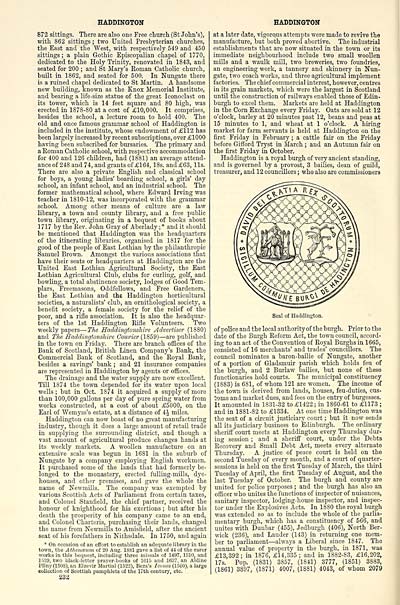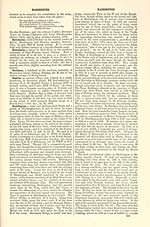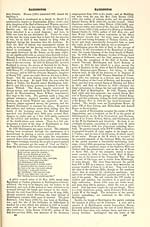Ordnance gazetteer of Scotland > Volume 3
(302) Page 232
Download files
Complete book:
Individual page:
Thumbnail gallery: Grid view | List view

HADDINGTON
872 sittings. Tiiere are also one Free church (St John's),
with 862 sittings ; two United Presbyterian churches,
the East and the West, with respectively 549 and 450
sittings ; a plain Gothic Episcopalian chapel of 1770,
dedicated to the Holy Trinity, renovated in 1843, and
seated for 200 ; and St Mary's Roman Catholic church,
built in 1862, and seated for 500. In Nungate there
is a ruined chapel dedicated to St Martin. A handsome
new building, known as the Knox Memorial Institute,
and bearing a life-size statue of the great Iconoclast on
its tower, which is 14 feet square and 80 high, was
erected in 1878-80 at a cost of £10,000. It comprises,
besides the school, a lecture room to hold 400. The
old and once famous grammar school of Haddington is
included in the institute, whose endowment of £112 has
been largely increased by recent subscriptions, over £1000
having been subscribed for bursaries. The primary and
a Roman Catholic school, with respective accommodation
for 400 and 126 children, had (1881) an average attend-
ance of 248 and 74, and grants of £164, 18s. and £63, Us.
There are also a private English and classical school
for boys, a young ladies' boarding school, a girls' day
school, an infant school, and an industrial school. The
former mathematical school, where Edward Irving was
teacher in 1810-12, was incorporated with the grammar
school. Among other means of culture are a law
library, a town and county library, and a free public
town library, originating in a bequest of books about
1717 by the Kev. John Gray of Aberlady ;* and it should
be mentioned that Haddington was the headquarters
of the itinerating libraries, organised in 1817 for the
good of the people of East Lothian by the philanthropic
Samuel Brown. Amongst the various associations that
have their seats or headquarters at Haddington are the
United East Lothian Agricultural Society, the East
Lothian Agricultural Club, clubs for curling, golf, and
bowling, a total abstinence society, lodges of Good Tem-
plars, Freemasons, Oddfellows, and Free Gardeners,
the East Lothian and the Haddington horticultural
societies, a naturalists' club, an ornithological society, a
benefit society, a female society for the relief of the
poor, and a rifle association. It is also the headquar-
ters of the 1st Haddington Rifle Volunteers. Two
weekly papers — The Haddingtonshire Advertiser (1880)
and The Haddingtonshire Cozjrier (1859) — are published
in the town on Friday. There are branch ofiices of the
Bank of Scotland, British Linen Company's Bank, the
Commercial Bank of Scotland, and the Royal Bank,
besides a savings' bank ; and 21 insurance companies
are represented in Haddington by agents or offices.
The drainage and the water supply are now excellent.
Till 1874 the town depended for its water upon local
■n-ells ; but in Oct. 1874 it acquired a supply of more
than 100,000 gallons per day of pure spring water from
works constructed, at a cost of about £5000, on the
Earl of Wemyss's estate, at a distance of 4J miles.
Haddington can now boast of no great manufacturing
industry, though it does a large amount of retail trade
in supplying the surrounding disti'ict, and though a
vast amount of agricultural produce changes hands at
its weekly markets. A woollen manufacture on an
extensive scale was begun in 1681 in the suburb of
Nungate by a company employing English workmen.
It purchased some of the lands that had formerly be-
longed to the monastery, erected fulling-mills, dye-
houses, and other premises, and gave the whole the
name of Newmills. The company was exempted by
various Scottish Acts of Parliament from certain taxes,
and Colonel Stanfield, the chief partner, received the
honour of knighthood for his exertions ; but after his
death the prosperity of his company came to an end,
and Colonel Charteris, purchasing their lands, changed
the name from Newmills to Amisfield, after the ancient
seat of his forefathers in Nithsdale. In 1750, and again
* On occasion of an effort to establish an adequate library in the
town, the Athenmujn of 20 Aug. ISSl gave a list of 44 of tlie rarer
works in this bequest, including three missals of 1497, 1510, and
1529, two black-letter prayer-books of 1615 and 1637, an Aldine
Pliny(150S), an Elzevir Martial (1522), Beza's Icones (15£0), a large
collection of Scottish pamphlets of the 17th century, etc.
232
HADDINGTON
at a later date, vigorqus attempts were made to revive the
manufacture, but both proved abortive. The industrial
establishments that are now situated in the town or its
immediate neighbourhood include two small woollen
mills and a waulk mill, two breweries, two foundries,
an engineering work, a tannery and skinnery in Nun-
gate, two coach works, and three agricultural implement
factories. The chief commercial interest, however, centres
in its grain markets, which were the largest in Scotland
until the construction of railways enabled those of Edin-
burgh to excel them. Markets are held at Haddington
in the Corn Exchange every Friday. Oats are sold at 12
o'clock, barley at 20 minutes past 12, beans and peas at
15 minutes to 1, and wheat at 1 o'clock. A hiring
market for farm servants is held at Haddington on the
first Friday in February ; a cattle fair on the Friday
before GifFord Tryst in March ; and an Autumn fair on
the first Friday in October.
Haddington is a royal burgh of very ancient standing,
and is governed by a provost, 3 bailies, dean of guild,
treasurer, and 12 councillors ; who also are commissioners
Seal of Haddington.
of police and the local authority of the burgh. Prior to the
date of the Burgh Reform Act, the town council, accord-
ing to an act of the Convention of Royal Burghs in 1665,
consisted of 16 merchants' and trades' councillors. The
council nominates a baron-bailie of Nungate, another
of a portion of Gladsmuir parish which holds feu of
the burgh, and 2 Burlaw bailies, but none of these
functionaries hold courts. The municipal constituency
(1883) is 681, of whom 121 are women. The income of
the town is derived from lands, houses, feu-duties, cus-
t-oms and market dues, and fees on the entry of bwgesses.
It amounted in 1831-32 to £1422 ; in 1860-61 to £1173 ;
and in 1881-82 to £1334. At one time Haddington was
the seat of a circuit justiciary court ; but it now sends
all its justiciary business to Edinburgh. The ordinary
sheriff court meets at Haddington every Thursday dur-
ing session ; and a sheriff court, under the Debts
Recovery and Small Debt Act, meets every alternate
Thursday. A justice of peace court is held on the
second Tuesday of every month, and a court of quarter-
sessions is held on the first Tuesday of March, the third
Tuesday of April, the first Tuesday of August, and the
last Tuesday of October. The burgh and county are
united for police purposes ; and the burgh has also an
officer who unites the functions of inspector of nuisances,
sanitary inspector, lodging-house inspector, and inspec-
tor under the Explosives Acts. In 1880 the royal burgh
was extended so as to include the whole of the parlia-
mentarj' burgh, which has a constituency of 566, and
unites with Dunbar (455), Jedburgh (406), North Ber-
wick (236), and Lauder (143) in returning one mem-
ber to parliament — always a Liberal since 1847. The
annual value of property in the burgh, in 1871, was
£13,392 ; in 1876, £14,335 ; and in 1882-83, £16,202,
17s. Pop. (1831) 3857, (1841) 3777, (1851) 3883,
(1861) 3897, (1871) 4007, (1881) 4043, of whom 2079
872 sittings. Tiiere are also one Free church (St John's),
with 862 sittings ; two United Presbyterian churches,
the East and the West, with respectively 549 and 450
sittings ; a plain Gothic Episcopalian chapel of 1770,
dedicated to the Holy Trinity, renovated in 1843, and
seated for 200 ; and St Mary's Roman Catholic church,
built in 1862, and seated for 500. In Nungate there
is a ruined chapel dedicated to St Martin. A handsome
new building, known as the Knox Memorial Institute,
and bearing a life-size statue of the great Iconoclast on
its tower, which is 14 feet square and 80 high, was
erected in 1878-80 at a cost of £10,000. It comprises,
besides the school, a lecture room to hold 400. The
old and once famous grammar school of Haddington is
included in the institute, whose endowment of £112 has
been largely increased by recent subscriptions, over £1000
having been subscribed for bursaries. The primary and
a Roman Catholic school, with respective accommodation
for 400 and 126 children, had (1881) an average attend-
ance of 248 and 74, and grants of £164, 18s. and £63, Us.
There are also a private English and classical school
for boys, a young ladies' boarding school, a girls' day
school, an infant school, and an industrial school. The
former mathematical school, where Edward Irving was
teacher in 1810-12, was incorporated with the grammar
school. Among other means of culture are a law
library, a town and county library, and a free public
town library, originating in a bequest of books about
1717 by the Kev. John Gray of Aberlady ;* and it should
be mentioned that Haddington was the headquarters
of the itinerating libraries, organised in 1817 for the
good of the people of East Lothian by the philanthropic
Samuel Brown. Amongst the various associations that
have their seats or headquarters at Haddington are the
United East Lothian Agricultural Society, the East
Lothian Agricultural Club, clubs for curling, golf, and
bowling, a total abstinence society, lodges of Good Tem-
plars, Freemasons, Oddfellows, and Free Gardeners,
the East Lothian and the Haddington horticultural
societies, a naturalists' club, an ornithological society, a
benefit society, a female society for the relief of the
poor, and a rifle association. It is also the headquar-
ters of the 1st Haddington Rifle Volunteers. Two
weekly papers — The Haddingtonshire Advertiser (1880)
and The Haddingtonshire Cozjrier (1859) — are published
in the town on Friday. There are branch ofiices of the
Bank of Scotland, British Linen Company's Bank, the
Commercial Bank of Scotland, and the Royal Bank,
besides a savings' bank ; and 21 insurance companies
are represented in Haddington by agents or offices.
The drainage and the water supply are now excellent.
Till 1874 the town depended for its water upon local
■n-ells ; but in Oct. 1874 it acquired a supply of more
than 100,000 gallons per day of pure spring water from
works constructed, at a cost of about £5000, on the
Earl of Wemyss's estate, at a distance of 4J miles.
Haddington can now boast of no great manufacturing
industry, though it does a large amount of retail trade
in supplying the surrounding disti'ict, and though a
vast amount of agricultural produce changes hands at
its weekly markets. A woollen manufacture on an
extensive scale was begun in 1681 in the suburb of
Nungate by a company employing English workmen.
It purchased some of the lands that had formerly be-
longed to the monastery, erected fulling-mills, dye-
houses, and other premises, and gave the whole the
name of Newmills. The company was exempted by
various Scottish Acts of Parliament from certain taxes,
and Colonel Stanfield, the chief partner, received the
honour of knighthood for his exertions ; but after his
death the prosperity of his company came to an end,
and Colonel Charteris, purchasing their lands, changed
the name from Newmills to Amisfield, after the ancient
seat of his forefathers in Nithsdale. In 1750, and again
* On occasion of an effort to establish an adequate library in the
town, the Athenmujn of 20 Aug. ISSl gave a list of 44 of tlie rarer
works in this bequest, including three missals of 1497, 1510, and
1529, two black-letter prayer-books of 1615 and 1637, an Aldine
Pliny(150S), an Elzevir Martial (1522), Beza's Icones (15£0), a large
collection of Scottish pamphlets of the 17th century, etc.
232
HADDINGTON
at a later date, vigorqus attempts were made to revive the
manufacture, but both proved abortive. The industrial
establishments that are now situated in the town or its
immediate neighbourhood include two small woollen
mills and a waulk mill, two breweries, two foundries,
an engineering work, a tannery and skinnery in Nun-
gate, two coach works, and three agricultural implement
factories. The chief commercial interest, however, centres
in its grain markets, which were the largest in Scotland
until the construction of railways enabled those of Edin-
burgh to excel them. Markets are held at Haddington
in the Corn Exchange every Friday. Oats are sold at 12
o'clock, barley at 20 minutes past 12, beans and peas at
15 minutes to 1, and wheat at 1 o'clock. A hiring
market for farm servants is held at Haddington on the
first Friday in February ; a cattle fair on the Friday
before GifFord Tryst in March ; and an Autumn fair on
the first Friday in October.
Haddington is a royal burgh of very ancient standing,
and is governed by a provost, 3 bailies, dean of guild,
treasurer, and 12 councillors ; who also are commissioners
Seal of Haddington.
of police and the local authority of the burgh. Prior to the
date of the Burgh Reform Act, the town council, accord-
ing to an act of the Convention of Royal Burghs in 1665,
consisted of 16 merchants' and trades' councillors. The
council nominates a baron-bailie of Nungate, another
of a portion of Gladsmuir parish which holds feu of
the burgh, and 2 Burlaw bailies, but none of these
functionaries hold courts. The municipal constituency
(1883) is 681, of whom 121 are women. The income of
the town is derived from lands, houses, feu-duties, cus-
t-oms and market dues, and fees on the entry of bwgesses.
It amounted in 1831-32 to £1422 ; in 1860-61 to £1173 ;
and in 1881-82 to £1334. At one time Haddington was
the seat of a circuit justiciary court ; but it now sends
all its justiciary business to Edinburgh. The ordinary
sheriff court meets at Haddington every Thursday dur-
ing session ; and a sheriff court, under the Debts
Recovery and Small Debt Act, meets every alternate
Thursday. A justice of peace court is held on the
second Tuesday of every month, and a court of quarter-
sessions is held on the first Tuesday of March, the third
Tuesday of April, the first Tuesday of August, and the
last Tuesday of October. The burgh and county are
united for police purposes ; and the burgh has also an
officer who unites the functions of inspector of nuisances,
sanitary inspector, lodging-house inspector, and inspec-
tor under the Explosives Acts. In 1880 the royal burgh
was extended so as to include the whole of the parlia-
mentarj' burgh, which has a constituency of 566, and
unites with Dunbar (455), Jedburgh (406), North Ber-
wick (236), and Lauder (143) in returning one mem-
ber to parliament — always a Liberal since 1847. The
annual value of property in the burgh, in 1871, was
£13,392 ; in 1876, £14,335 ; and in 1882-83, £16,202,
17s. Pop. (1831) 3857, (1841) 3777, (1851) 3883,
(1861) 3897, (1871) 4007, (1881) 4043, of whom 2079
Set display mode to: Large image | Transcription
Images and transcriptions on this page, including medium image downloads, may be used under the Creative Commons Attribution 4.0 International Licence unless otherwise stated. ![]()
| Gazetteers of Scotland, 1803-1901 > Ordnance gazetteer of Scotland > Volume 3 > (302) Page 232 |
|---|
| Permanent URL | https://digital.nls.uk/97380078 |
|---|
| Attribution and copyright: |
|
|---|---|

